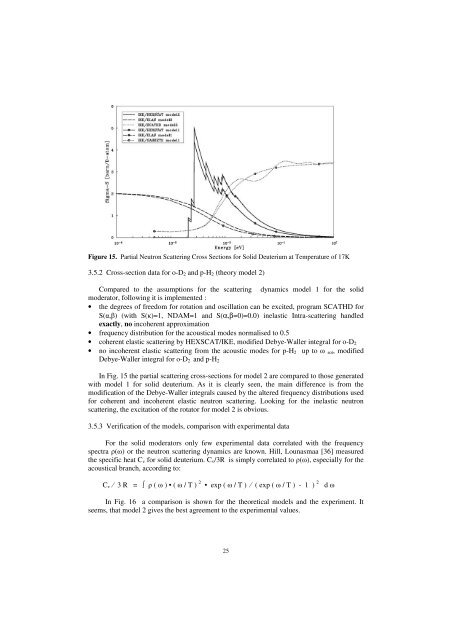Druck-Materie 20b.qxd - JUWEL - Forschungszentrum Jülich
Druck-Materie 20b.qxd - JUWEL - Forschungszentrum Jülich
Druck-Materie 20b.qxd - JUWEL - Forschungszentrum Jülich
You also want an ePaper? Increase the reach of your titles
YUMPU automatically turns print PDFs into web optimized ePapers that Google loves.
Figure 15. Partial Neutron Scattering Cross Sections for Solid Deuterium at Temperature of 17K<br />
3.5.2 Cross-section data for o-D2 and p-H2 (theory model 2)<br />
Compared to the assumptions for the scattering dynamics model 1 for the solid<br />
moderator, following it is implemented :<br />
• the degrees of freedom for rotation and oscillation can be excited, program SCATHD for<br />
S(α,β) (with S(κ)=1, NDAM=1 and S(α,β=0)=0.0) inelastic Intra-scattering handled<br />
exactly, no incoherent approximation<br />
• frequency distribution for the acoustical modes normalised to 0.5<br />
• coherent elastic scattering by HEXSCAT/IKE, modified Debye-Waller integral for o-D2<br />
• no incoherent elastic scattering from the acoustic modes for p-H2 up to ω rot, modified<br />
Debye-Waller integral for o-D2 and p-H2<br />
In Fig. 15 the partial scattering cross-sections for model 2 are compared to those generated<br />
with model 1 for solid deuterium. As it is clearly seen, the main difference is from the<br />
modification of the Debye-Waller integrals caused by the altered frequency distributions used<br />
for coherent and incoherent elastic neutron scattering. Looking for the inelastic neutron<br />
scattering, the excitation of the rotator for model 2 is obvious.<br />
3.5.3 Verification of the models, comparison with experimental data<br />
For the solid moderators only few experimental data correlated with the frequency<br />
spectra ρ(ω) or the neutron scattering dynamics are known. Hill, Lounasmaa [36] measured<br />
the specific heat Cv for solid deuterium. Cv/3R is simply correlated to ρ(ω), especially for the<br />
acoustical branch, according to:<br />
Cv ⁄ 3 R = ∫ ρ ( ω ) • ( ω / T ) 2 • exp ( ω / T ) ⁄ ( exp ( ω / T ) - 1 ) 2 d ω<br />
In Fig. 16 a comparison is shown for the theoretical models and the experiment. It<br />
seems, that model 2 gives the best agreement to the experimental values.<br />
25

















